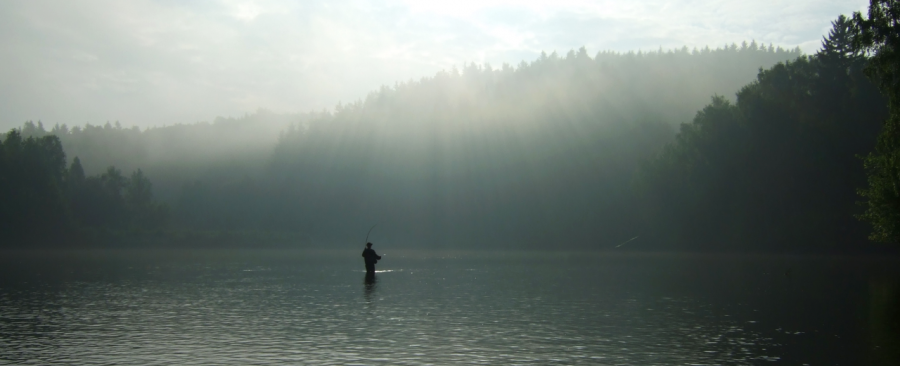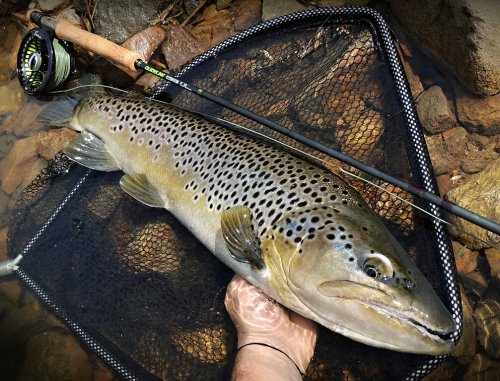A universal guide to stillwater fly fishing for trout, which traditionally contains absolutely everything you need to know about this increasingly popular fly fishing technique. You will learn the right techniques and tactics of fishing, the right fly fishing equipment and, of course, TOP stillwater flies for catching salmonid fish on commercial artificial but also natural still waters.

Stillwater fly fishing is now an integral part of our beautiful and originally conceived sport fishing with an artificial fly. When I think about it very loftily, one could say with exaggeration that compared to fishing on flowing waters, this is actually the opposite technique/tactic of fishing, because on rivers and streams the fisherman actively moves and catches fish in a position = "standing" in a certain river parts. BUT on the lake (in the case of the commonly practiced shore concept of stillwater fly fishing, which I commonly see in the Czech Republic and Europe, The Great Britain as well), the fisherman does not move much, he consistently casts and "waits" before a fish (school of fish) actively approaches to his flies!
Of course, as I indicated above, this must be taken with a big margin, because if you want to be successful when fishing on still water, you have to constantly monitor the environment, try different types of fly lines, combine sets of artificial flies and fishing techniques, look for fish and always adapt to their moods and very often variable conditions depending on many other factors such as the season, weather, air temperature and especially water in connection with the amount of oxygen dissolved in it, etc.

🤔 I have to admit that for me personally, stillwater fly fishing - fishing for trout fish on stagnant waters - is a huge passion and an endless challenge, thanks to which I have aimed most of my fishing expeditions in recent years at different types of still waters, which attract me mainly for their mystery, more difficult to read (than is the case, for example, with smaller and medium-sized rivers) and, above all, great moodiness (rather with stocked fish) and unpredictability and pickiness/experience (especially with native fish) of the trout that inhabit these still waters.
Of course, another driving force - in conjunction with the mentioned mystery of the lake depths - is also the size of the fish, which the angler always assumes to be larger than on smaller and medium-sized running waters! Compared to river fishing, which today is mainly characterized by nymphing and fishing with a French leader, what I also like about stillwater fly fishing is that - although it is certainly not the classic technique of artificial fly fishing - it still preserves the traditional principles of fly fishing as such, namely fishing and regular casting with fly line as the main supporting element of light flies! 😉
If I jump for a moment to the cradle of stillwater fly fishing - to England - then in the conditions there, stillwater fly fishing is divided into fishing on large still waters, which mainly include large reservoirs with drinking water and normal size several hundred hectares (Rutland, Grafham, Pitsford, Bewl, Blagdon, Farmoor, Ravethrope, Draycote, Eyebrook, etc.), and for fishing on small stillwaters, which are of different character and water purity (whether stalking waters with with clear water and several years of tradition - Avington, Dever Springs, Avon Springs, etc., or classic smaller man-made stands of a similar character.

After this example, we can say with our heads down that there are really only a few areas in the Czech Republic that we can safely say that we can classify them as areas where it is possible to actively sport fishing for salmonid fish on a fly!
As I have already lamented and criticized the use and stocking of certain types of water by the Czech Fishing Association (Czech Fishing Union - Český rybářský svaz) in the article "At The Vice - AR Suspender Pin Fry", it is a great pity that in this regard the great potential of suitable large water reservoirs, smaller equalization reservoirs, flooded san pits with clear water, etc., on which it would be possible to farm very successfully only in trout mode and subsequently stillwater fly fish - fishing for normally large trout from the shore or from boats with artificial flies just as successfully as is the case, for example, in the aforementioned England, but of course also elsewhere in the world, where they are obviously not in charge! But... Welcome to Czech Republic, the Carp-Everywhere Country. 😔
In any case, if we focus on the positive side of things - in our conditions, we can divide the few areas with salmonid fish, and therefore suitable for stillwater fly fishing, into private and national/union trout still waters... Of course, with certain exceptions and combinations of these two types areas.
◼ Private stillwaters mainly include commercial ponds with a regularly renewed stock of stocked rainbows, brooktrout and nowadays often Kolowrats (the Italian form of brown trout bred in classic "rainbow trout fisheries").
◼ National/Union stillwaters are mostly leveling and other smaller to medium-sized reservoirs built on a trout stream or river with native brown trout and possibly grayling with the occasional introduction of rainbow trout and brook trout with, unfortunately, relatively precisely defined "time for free life" ( 7 - 14 days after stocking), because it is of course not our custom to defend a stocked and inexperienced fish for at least some time! I've honestly only experienced this on one water.

In any case - due to the population of these types of waters, our fishing approach should always be different, because the behavior and eating habits of stocked rainbows are diametrically different from those of the native brown trout from stagnant water, where they often grew up from their birth or rather from planting in the form of fry or one year fish!
⭐ In this FLY FISHING SPECIAL, I will focus in detail on all the key aspects of stillwater fly fishing on artificial/private and union/natural still waters, both from the point of view of the most frequently used fishing techniques and tactics, specific stillwater flies and, of course, the most suitable stillwater fly fishing equipment for fishing for trout from still waters!
❗ So, if you want to become a successful stillwater fly fisherman, read this collection of related articles from my other comprehensive special and enjoy trout fishing on still waters, whether on those heavily stocked private ones or on the forgotten natural ones that rise from their depths from time to time they will release interesting surprises in the form of trophy native brown trout or larger and beautifully colored rainbows that have survived the "post-stocking slaughter" and survived at least one winter in the reservoir (as the English say: "Overwintered fish")! So don't miss the following articles in this stillwater fly fishing series:
➡ TOP FLIES FOR STILLWATER TROUT
➡ TACTICS & TECHNIQUES FOR STILLWATER TROUT
➡ TACKLE & EQUIPMENT OF STILLWATER FLY FISHERMAN
In addition of these publications, you will of course also find a lot of very interesting historical articles and galleries on our website, which are devoted to the topic of stillwater fly fishing - just go to it - compared to earlier times, today there is a huge amount of available information available! 😉
So I wish you a pleasant and informative reading of my other FLY FISHING SPECIAL, which this time I dedicated to one of my most favorite fly fishing disciplines! Tigh Lines, Aleš 🎣🍀























